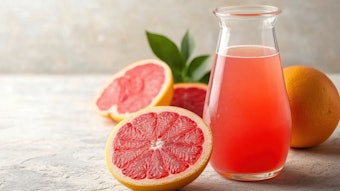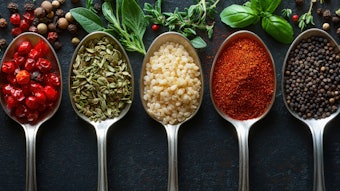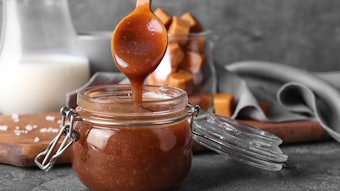
Replacing acetaldehyde for regulatory reasons is an interesting challenge. The character of this aldehyde is quite distinctive, sharp and pungent, adding unique freshness to a wide range of profiles but especially important for juicy orange flavors. Propionaldehyde is one possibility, but it has a noticeably harsher character than acetaldehyde. Additionally, the distinct disadvantage of readily forming acetals with propylene glycol is having peculiarly unattractive profiles. The next best alternatives are the acetals of acetaldehyde itself. A wide range are now available and most have attractive profiles. Of these, the best option is probably the most obvious, acetal (FEMA# 2002, CAS# 105-57-7), which is the simple acetal formed from acetaldehyde and ethanol.
Acetal has some odor profile similarity to acetaldehyde. It is rather less pungent and has a more noticeable ethereal secondary odor, but it makes quite a good alternative to acetaldehyde in many flavors. The unique advantage to acetal is the fact that the profile differences from acetaldehyde actually make it a superior choice in several useful categories.
Note that the dose rates given throughout this article are the levels suggested for use in flavors intended to be dosed at 0.05% in ready-to-drink beverages or in a simple bouillon.
Orchard Fruit Flavors
Pear: If acetaldehyde is superior to acetal in orange flavors, there is no question that acetal is superior to acetaldehyde in pear flavors. It adds freshness and an intriguing aspect of pear skin character. The ideal level of use of acetal in pear flavors is 10,000 ppm, although even higher levels can be used for an exaggerated effect.
Apple: The effect in apple flavors is similar to that in pear flavors – adding freshness and enhancing the skin notes – but the ideal level of addition is a little lower, around 2,000 ppm.
Cherry: An acetal level of 2,000 ppm also boosts the skin note in realistic style cherry flavors and adds a juicy note.
Peach: The skin aspect is also helpful in peach flavors, brightening and lifting the profile. The ideal level depends on the style of flavor but 1,500 ppm is a good starting point.
Apricot: Fresh apricot flavors are somewhat similar to peach flavors and the ideal level of addition of acetal is similar, in the region of 1,000 ppm. Dried apricot flavors do not really benefit from the use of this ingredient.
Tropical Fruit Flavors
Banana: Banana flavors are an extreme example of the challenging but attractive contest between heavy and bright notes. Acetal is very much on the bright end of the scale and lightens banana flavors superbly at 3,000 ppm.
Guava: Guava flavors can also be a little heavy and cloying. A level of 1,000 ppm adds lift and freshness and also gives a little emphasis to the skin notes.
Kiwi: In contrast, kiwi flavors can often become too light and insubstantial. A level of 2,000 ppm of acetal adds welcome freshness, but should also be counterbalanced by more substantial notes.
Pineapple: Pineapple flavors that aim to reproduce nature and rely less than normal on allyl esters can seem a little flat and lacking in pungency. Acetal helps to restore pungency and freshness at 2,000 ppm.
Melon: Acetal is helpful, in a much more subtle way, in all melon flavors. A good level of addition to watermelon flavors is 250 ppm and 150 ppm is more suitable for other types of melon, such as cantaloupe.
Berry Fruit Flavors
Blackberry: The effect of acetal is relatively modest in berry flavors but it still adds notable freshness and an element of skin character even at moderate levels. The ideal level of addition to blackberry flavors is 200 ppm.
Blueberry: A better level for blueberry flavors is 600 ppm, adding notable lift and fresh character to what is often a quite floral foundation.
Raspberry: This ingredient is, in my opinion, more helpful in raspberry flavors than in any other flavors in the berry category. A level of 300 ppm adds freshness, together with an almost undefineable “hairy” character that brings back memories of home grown fruit.
Citrus Fruit Flavors
Orange: This flavor profile represents the biggest challenge in respect of the replacement of acetaldehyde. Acetal is not a perfect replacement but it performs well at 500 ppm.
Grapefruit: A level of 300 ppm of acetal is quite helpful in grapefruit juice flavors, enhancing freshness and juice character.
Lemon: A level of 300 ppm also has a similar effect in juice style, or old fashioned lemonade style, lemon flavors.
Tangerine: Tangerine flavors are generally less juicy in character than orange flavors and the ideal level of addition is lower, around 200 ppm.
Other Fruit Flavors
Grape: Acetal is very helpful in both the floral white grape flavors, such as muscat, and the more substantial red Concord grape flavors. A level of 2,000 ppm lifts the profiles of both categories and adds skin characteristics.
Rhubarb: This minor fruit category is often over-reliant on a single component and 200 ppm of acetal fits into the profile very harmoniously, adding complexity, lift and freshness.
Brown Flavors
Caramel and Toffee: In these categories of flavors the effect of acetal is necessarily quite subtle, only 50 ppm is needed to give a subtle lift to the profile.
Cocoa and Chocolate: Cocoa flavors are brightened perceptibly by the addition of around 100 ppm of acetal. Similarly, chocolate flavors are best served by around 50 ppm.
Vanilla Bean: A level of 400 ppm of acetal adds authenticity in vanilla bean-style vanilla flavors, not so much by adding to the actual character of the beans, but more by replicating a little of the character of aged vanilla alcoholic extracts.
Alcoholic Drink Flavors
Whisky: Acetal really comes into its own in whisky flavors, adding to the impact and taming to some extent the fusel notes. An level of 2,000 ppm is ideal.
Rum: A similar 2,000 ppm level is equally effective in all styles, light and dark, of rum flavors.
Brandy: A little less, nearer 1,000 ppm, works better in most brandy flavors, giving a pleasant lift to the profile.
Other Flavors
Walnut: Acetal has some use in all nut flavors but by far the best effect is in walnut flavors. A level of 200 ppm adds attractive complexity and lifts the profile.











